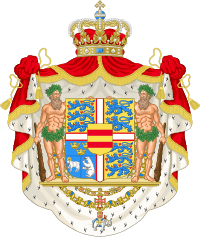Henrik, Prince Consort of Denmark
Prince Henrik of Denmark (Danish pronunciation: [ˈhenˀʁek]; born Henri Marie Jean André de Laborde de Monpezat; 11 June 1934 – 13 February 2018)[1] was the husband of Queen Margrethe II of Denmark.
| Prince Henrik | |
|---|---|
 Prince Henrik at the wedding of Victoria, Crown Princess of Sweden, and Daniel Westling, 19 June 2010 | |
| Consort of the Danish monarch | |
| Tenure | 14 January 1972 – 13 February 2018 |
| Born | Henri Marie Jean André de Laborde de Monpezat 11 June 1934 Talence, Gironde, France |
| Died | 13 February 2018 (aged 83) Fredensborg Palace, Denmark[1] |
| Burial | 20 February 2018 Ashes partly scattered across Danish seas, partly interred in the private gardens of Fredensborg Palace[2] |
| Spouse | |
| Issue |
|
| House | Monpezat |
| Father | André de Laborde de Monpezat |
| Mother | Renée-Yvonne Doursennot |
| Religion | Church of Denmark prev. Roman Catholic |
| Military career | |
| Allegiance | |
| Service/ | |
| Years of service | 1959–1962 (end of active service) |
| Rank | General (Army) General (Air Force) Admiral (Navy) |
| Battles/wars | Algerian War |
| Awards | Mentioned in dispatches Order of the Elephant Order of the Legion of Honour |
Henrik was born in the French commune of Talence near Bordeaux to an old French family, the Laborde de Monpezats. He spent his early years in Tonkin in French Indochina (now part of Vietnam), where his family had lived for many years. The family spent the Second World War at the family home in Cahors, France. They returned to French Indochina after the war. However, they were forced to flee following the defeat of the French in the First Indochina War. After completing his education in France and Vietnam, Henrik served in the French Army during the Algerian War. Prior to his marriage to Margrethe, he worked in the diplomatic service. He married Margrethe at the Holmen Church on 10 June 1967 and became her prince consort when she succeeded her father, King Frederick IX, as monarch of Denmark on 14 January 1972.[3]
He had two sons, Crown Prince Frederik (born 1968) and Prince Joachim (born 1969), and eight grandchildren. Throughout his time as Prince consort, Henrik voiced his displeasure with the fact that he never received the title of king.[4]
A keen winemaker, Henrik produced his own wine at his estate in France. He also published many works of poetry. He was the first male consort to a Danish monarch. Henrik retired from his royal duties on 1 January 2016, at the age of 81. He died in Fredensborg Palace on 13 February 2018, after a short illness.
Early life
.jpg)
Henrik was born in Talence, Gironde, France. He was the son of André de Laborde de Monpezat (6 May 1907 in Mont-de-Marsan – 23 February 1998 in Le Cayrou) and his wife, Renée Doursenot (26 October 1908 in Périgueux – 11 February 2001 in Le Cayrou[5]) (married in 1948[6][7][8][9]). He had two younger brothers, Étienne and Jean-Baptiste, and two older sisters, Françoise, Mme. Bardin and Maurille, Mme. Beauvillain (d. 2015). He was raised as a Catholic.[10]
He spent his first five years in Hanoi in Tonkin in French Indochina (now part of Vietnam), where his father looked after family business interests.[11] In 1939, the family returned to Le Cayrou, where they remained during the Second World War.[5] Henrik received homeschooling until 1947, when he went to a Jesuit school in Bordeaux.[11] He returned to Hanoi in Tonkin in 1950, where increasing unrest forced him to fight the Việt Minh, to protect his family's lands.[12] He graduated from the French secondary school in Hanoi in 1952.[11] Originally wanting to study to become a pianist at Conservatoire de Paris, he instead chose an education more in line with his father's wishes.[13] Between 1952 and 1957 he simultaneously studied law and political science at the Sorbonne, Paris, and Chinese and Vietnamese at the École Nationale des Langues Orientales (now known as INALCO). He also studied in Hong Kong in 1957 and Saigon in 1958.[11]
He served as an infantry conscript in the French Army in the Algerian War between 1959 and 1962.[12] He then joined the French Foreign Ministry, working as a Secretary at the embassy in London from 1963 to 1967.[11] While there, he met Princess Margrethe, who was studying at the London School of Economics.[13] The couple secretly dated for a year before Henrik proposed.[13]
Marriage

On 10 June 1967 he married Princess Margrethe, the heir presumptive to the Danish throne, at the Naval Church of Copenhagen. At the time of the wedding his name was Danicised to Henrik and he was given the title HRH Prince Henrik of Denmark. Prior to the wedding, the Prince converted to Lutheranism.[10] The Queen and Prince Henrik had two children, Crown Prince Frederik and Prince Joachim, and eight grandchildren.
Prince Henrik's native language was French, and his second language was Danish. He also spoke fluent English, German, Chinese, and Vietnamese. Although he quickly learned Danish after marrying Margrethe, Danes joked about his grasp of Danish and his thick French accent.[14]
Difficulties with the Danish monarchy
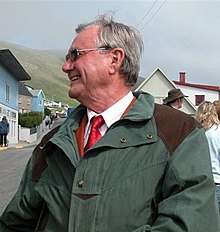
When Queen Margrethe II ascended the throne, Henrik became the first male consort in Danish history.[13] This meant there were no clear descriptions of his duties. He defined his own role as a supporter of and counsellor to the Queen. However, he felt frustrated with the lack of recognition in title, stating that there wasn't any way to differentiate between his own title and those of his sons and grandsons.[13]
In 2002, Henrik fled Denmark and went to stay at the couple's Château de Caïx in Cahors in southern France. The cause of his departure from Denmark was a New Year's Day reception in which his son, Crown Prince Frederik, had been appointed as host in the absence of Queen Margrethe. Henrik felt "pushed aside, degraded and humiliated"[15] by being relegated to "third place in the royal hierarchy".
"For many years I have been Denmark's number two," he said. "I've been satisfied with that role, but I don't want to be relegated to number three after so many years." Henrik "fled" Denmark to reflect on his status in the Danish Royal Family. Queen Margrethe flew to France to meet her husband.[15] Henrik stressed that neither his wife nor son were to blame for the incident. The Prince Consort spent three weeks in Caix, and did not appear with his wife as expected at the wedding of Willem-Alexander of the Netherlands and Máxima Zorreguieta.[16] After three weeks, Henrik returned to Denmark.
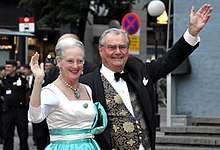
On 30 April 2008, shortly before the wedding of his younger son, Prince Joachim, to Marie Cavallier, the Queen conferred the new Danish title "Count of Monpezat" (Danish: Greve af Monpezat) on both of her sons and made it hereditary for their male-line descendants, both male and female.[17] The Queen's private secretary Henning Fode commented, "The Queen and the Prince Consort have considered this for quite some time, and it has led to the belief that it was the right thing to do."[17] In fact, Henrik had mentioned this possibility as far back as 1996 in his published memoir: "During our generation the future sovereign will perhaps receive approval to see 'Monpezat' added to the dynastic name of 'Oldenburg-Glücksburg'".[18] While being interviewed by the French weekly Point de Vue in October 2005, Henrik raised the issue shortly after the birth of Crown Prince Frederik's first son, Prince Christian, who is expected to inherit the Danish crown one day: "It also makes him very proud and happy that Monpezat will be added to this small grandson's future name as Prince of Denmark. 'It is a great joy for me that his French roots will also be remembered.'"[19]
In her New Year's speech to the Danish people on 31 December 2015, Queen Margrethe announced that Prince Henrik would 'wind down' and give up most of his official duties beginning on 1 January 2016. On 14 April 2016, Prince Henrik renounced the title of Prince Consort, which he had been given in 2005.[20][21]
In August 2017, he announced that he would not be buried next to his wife in Roskilde Cathedral, where Danish royals have been buried since 1559. According to a royal house spokeswoman, Queen Margrethe, who had a specially designed sarcophagus made for the couple, reluctantly accepted Henrik's decision.[22][23][24]
Cultural interests and hobbies
Like his wife, Prince Henrik was deeply interested in art and culture. He was particularly fond of wooden figures and jade, building up collections which he exhibited in 2017 at the museum in Koldinghus.[25] Although he never achieved his ambition of becoming a concert pianist, he continued to play the piano throughout his life. In 2013, he accompanied the pop group Michael Learns to Rock on the piano as they recorded "Echo", a number which was presented to the king of Thailand.[26][13]
Henrik wrote many poems in his native language (French), some of which have been published in the collections Chemin faisant (1982), Cantabile (2000), Les escargots de Marie Lanceline (2003), Murmures de vent (2005), Frihjul (Roue-Libre, 2010), Fabula (2011), La part des anges (2013), and Dans mes nuits sereines (2014). The symphonic suite Cantabile by Frederik Magle is based on Henrik's poetry collection Cantabile and was premiered by the Danish National Symphony Orchestra at two concerts celebrating Henrik's 70th and 75th birthdays in 2004 and 2009. Henrik said about writing poetry (translated from Danish): "I see poetry as an opportunity for immersion in a superficial time dominated by news and entertainment that makes us rootless and restless. Poetry takes us closer to the true nature of the world, in poetry we can approach the eternal questions such as love, loneliness and death."[27]
Henrik was also an excellent cook, inspired by French gastronomic traditions. He usually planned the family meals in collaboration with the court chef, always including his own spices on the table, some from his childhood estates in Asia. In addition to his cookbooks, Henrik often appeared in television programmes showing how he prepared meals in Fredensborg Castle in Denmark or at his French home, the Château de Cayx.[13]
Death
In August 2017, Henrik announced he did not wish to be buried next to the Queen, citing his longtime complaint of only being named Prince Consort, and not King Consort.[28][29] The decision is said to have broken a tradition that began in 1559,[30] and at the time, Queen Margrethe is said to have accepted her husband's decision.[28][29]
On 6 September 2017, it was announced that Prince Henrik was suffering from dementia.[31] On 28 January 2018, he was hospitalized at Rigshospitalet, following a visit to Egypt.[32] It was later revealed that he had a benign tumor in the left lung.[33] His health however worsened, causing Crown Prince Frederik to cut short his visit to South Korea where he was to attend the 2018 Winter Olympics in Pyeongchang.[34] On 13 February 2018, Prince Henrik was transferred from Rigshospitalet to Fredensborg Palace, where the Danish Royal Court stated he wished to spend the remaining days of his life. The Royal Court added that the condition of the Prince remained serious.[35] On 14 February 2018, it was announced that Prince Henrik had died in his sleep at Fredensborg Palace late on 13 February, surrounded by his wife and sons.[1]
Following his death, the Court announced there would be a month of royal mourning.[36] Henrik's casket was placed in The Palace Chapel at Christiansborg for a castrum doloris, where in the following two days, more than 19,000[37] people went to pay their respects.[38] He was cremated on 20 February, with half of the ashes scattered across Danish seas and half placed in the private part of the gardens at Fredensborg Palace.[2]
Family
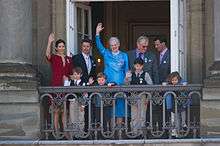
Prince Henrik had two sons and eight grandchildren, all born at Rigshospitalet in Copenhagen:
- Crown Prince Frederik (born 26 May 1968). He was married to Mary Donaldson on 14 May 2004 at Copenhagen Cathedral, Copenhagen. The couple have four children:
- Prince Christian (born 15 October 2005)
- Princess Isabella (born 21 April 2007)
- Prince Vincent (born 8 January 2011)
- Princess Josephine (born 8 January 2011)
- Prince Joachim (born 7 June 1969). He was married to Alexandra Manley on 18 November 1995 at Frederiksborg Palace Church, Hillerød. They divorced on 8 April 2005. He was married secondly to Marie Cavallier on 24 May 2008 at Møgeltønder Church, Møgeltønder. Joachim has four children; three sons and one daughter:
- Prince Nikolai (born 28 August 1999)
- Prince Felix (born 22 July 2002)
- Prince Henrik (born 4 May 2009)
- Princess Athena (born 24 January 2012)
In 2008, Queen Margrethe II announced that her male-line descendants would bear the additional title of Count or Countess of Monpezat, in recognition of Prince Henrik's ancestry.[17]
Titles, styles and honours
| Coat of Arms of Henrik, Prince Consort of Denmark | |
|---|---|
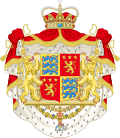 | |
| Armiger | Henrik, Prince Consort of Denmark |
Titles and styles
- 11 June 1934 – 10 June 1967: Count* Henri de Laborde de Monpezat
- 10 June 1967 – 2005: His Royal Highness Prince Henrik of Denmark
- 2005 – 14 April 2016: His Royal Highness The Prince Consort of Denmark[39]
- 14 April 2016 – 13 February 2018: His Royal Highness Prince Henrik of Denmark[21]
* Use is disputed, see section "French title controversy" below
French title controversy
The Laborde de Monpezat family style themselves as counts, though their right to the use of that title is disputed; The Encyclopédie de la fausse noblesse et de la noblesse d'apparence (English: Encyclopedia of False and Seeming Nobility) states that Prince Henrik's ancestor, Jean Laborde, received royal letters patent of ennoblement in 1655, conditional on his reception as a noble in the Estates of the province of Béarn where his lands were located.[40] But this condition was never fulfilled, as the Estates refused Laborde's petitions in 1703 and again in 1707.[40] The family's surname was "Monpezat" by the time of the French Revolution, without title, until 14 July 1860, when it was changed by imperial decree to "de Laborde-Monpezat", and legally changed again on 19 May 1861 to "de Laborde de Monpezat".[8] Although the comital title has been used by the family as if it were a courtesy title, traditionally the royal court and French society accepted such titles when used by genuinely noble families.[41]
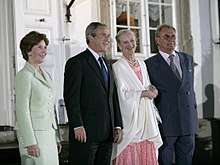
Although Danish law never required that royal spouses be of aristocratic origin, no heir's marriage to a person who lacked male-line descent from royalty or titled nobility had been accepted as dynastic by the sovereign in the course of Denmark's history as a hereditary monarchy, until the marriage of the heir presumptive, Princess Margrethe, in June 1967 to "Count" Henri de Laborde de Monpezat.[42][43] Six months later Margrethe's first cousin, Prince Ingolf of Denmark, married an untitled commoner and was demoted to a count, and when another cousin, Prince Christian of Denmark, also wed a Dane, Anne Dorte Maltoft-Nielsen, in 1971, he forfeited his dynastic position.[43]
Honours
National honours and awards
National honours:[11]













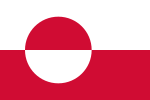







Foreign honours and awards
Foreign honours:[11]

.svg.png)







































Ancestry
| Ancestors of Henrik, Prince Consort of Denmark | |||||||||||||||||||||||||||||||||||||||||||||||||||||||||||||||||||||||||||||||||||||||||||||||||||||||||||||||||||||||||||||||||||||||||||||||||||||||||||||||||||||||||||||||||||||||||||||||||||||||||||||||||||||||||||||||||||||||||||||||||||||||||||||||||||||||||||||||||||||||||
|---|---|---|---|---|---|---|---|---|---|---|---|---|---|---|---|---|---|---|---|---|---|---|---|---|---|---|---|---|---|---|---|---|---|---|---|---|---|---|---|---|---|---|---|---|---|---|---|---|---|---|---|---|---|---|---|---|---|---|---|---|---|---|---|---|---|---|---|---|---|---|---|---|---|---|---|---|---|---|---|---|---|---|---|---|---|---|---|---|---|---|---|---|---|---|---|---|---|---|---|---|---|---|---|---|---|---|---|---|---|---|---|---|---|---|---|---|---|---|---|---|---|---|---|---|---|---|---|---|---|---|---|---|---|---|---|---|---|---|---|---|---|---|---|---|---|---|---|---|---|---|---|---|---|---|---|---|---|---|---|---|---|---|---|---|---|---|---|---|---|---|---|---|---|---|---|---|---|---|---|---|---|---|---|---|---|---|---|---|---|---|---|---|---|---|---|---|---|---|---|---|---|---|---|---|---|---|---|---|---|---|---|---|---|---|---|---|---|---|---|---|---|---|---|---|---|---|---|---|---|---|---|---|---|---|---|---|---|---|---|---|---|---|---|---|---|---|---|---|---|---|---|---|---|---|---|---|---|---|---|---|---|---|---|---|---|---|---|---|---|---|---|---|---|---|---|---|---|---|---|---|---|
| |||||||||||||||||||||||||||||||||||||||||||||||||||||||||||||||||||||||||||||||||||||||||||||||||||||||||||||||||||||||||||||||||||||||||||||||||||||||||||||||||||||||||||||||||||||||||||||||||||||||||||||||||||||||||||||||||||||||||||||||||||||||||||||||||||||||||||||||||||||||||
Publications
Prince Henrik translated several books into Danish and published several other books.
- In 1981, under the pseudonym H.M. Vejerbjerg he and the Queen translated Simone de Beauvoir's Tous les hommes sont mortels.
- Chemin faisant, 1982, a volume of French poems.
- Destin oblige, 1996, his memoirs as Prince Consort.
- Ikke Altid Gåselever (not always foie gras), 1999, a selection of favourite recipes.
- Cantabile, 2000, poems.
- Les escargots de Marie Lanceline, 2003.
- Murmures de vent, 2005, poems.
- Frihjul, 2010, poems.
References
- Danish Royal Family (14 February 2018). "HRH Prince Henrik has Died". kongehuset.dk (in Danish). Retrieved 14 February 2018.
- Madsen, Katrine Rørby; Hyldal, Christine (14 February 2018). "Prins Henrik bisættes på tirsdag og halvdelen af asken spredes over danske farvande" [Prince Henry to be interred on Tuesday with half of the ashes spread across Danish Seas]. DR.dk (in Danish). Danmarks Radio. Retrieved 14 February 2018.
- "Prince Henrik of Denmark". Kongehuset. 14 February 2018. Retrieved 15 February 2018.
- "Denmark's Prince Henrik, who wanted to be king, dies at 83". BBC. 14 February 2018.
- Svendsen, Helge (12 February 2001). "Obituary: Countess de Monpezat". jyllands-posten.dk (in Danish). JP/Politikens Hus A/S. Retrieved 13 February 2018.
- Chevé, Joëlle (1998). La Noblesse du Périgord: Au pays des 1.000 châteaux (in French). FeniXX. ISBN 9782262059743.
En 1948, André de Laborde de Monpezat épouse à Cahors, Renée Doursenot, née en 1908 à Périgueux, fille de Maurice, employé des chemins de fer, et de Marguerite Gay, repasseuse. De ce mariage naissent huit enfants dont l'aîné, Henri, sera prince consort de Danemark: né à Talence en 1934... (In 1948, André de Laborde de Monpezat married in Cahors, Renée Doursenot, born in 1908 in Périgueux, daughter of Maurice, railway employee, and Marguerite Gay, ironer. From this marriage are born eight children, the eldest of whom, Henri, will be Prince Consort of Denmark: born in Talence in 1934...)
- de Diesbach, Ghislain (3 March 2016). Les secrets du Gotha (in French). Éditions Place des éditeurs. ISBN 978-2-262-06650-5.
Il suffit de rappeler qu'André Laborde de Monpezat, marié d'abord religieusement en 1934, contrairement à la loi, avec Renée Doursenot, déjà mariée et en instance de divorce, à dû attendre que celui-ci soit prononcé pour l'épouser, civilement cette fois (...) et du coup légitimer, en les faisant inscrire à l'état civil, tous les enfants nés déjà de son mariage religieux. (Suffice it to say that André Laborde de Monpezat, who was first religiously married in [6 January] 1934, in contravention of the law, to Renée Doursenot, already married [to Louis Leuret (on 29 Sept 1928), a defrocked priest] and in the process of divorcing, had to wait until it [the divorce] was pronounced [by the French Civil Court in Saigon on 21 Sept 1940] to marry her, civilly this time (...) and thus legitimise, by making them register with the civil status, all the children born already from his religious [unlawful] marriage [According to French republican law, approved by State-Church agreements, a religious marriage is sanctioned if pronounced before the civil marriage].)
- Joseph Valynseele, Les de Laborde de Monpezat et leurs alliances, Paris, chez l'Auteur, 1975, French
- Miller, Frederic P; Vandome, Agnes F; McBrewster, John (18 October 2010). Henrik, Prince Consort of Denmark. VDM Publishing. ISBN 9786131781223.
- Barbara, Augustin (1989). Marriage across frontiers. Multilingual Matters. p. 40. ISBN 1-85359-041-X. Retrieved 1 October 2009.
Laborde de Monpezat.
- Danish Royal Family. "HRH Prince Henrik". kongehuset.dk (in Danish). Danish Royal Family. Retrieved 13 February 2018.
- Elkjær, Kenneth (18 June 2014). "Prince Henrik Reveals His Bloody Past: We shot and human lives were lost". BT.dk (in Danish). Berlingske Media A/S. Retrieved 13 February 2018.
- Surrugue, Stéphanie Marie; Vestergaard, Nikoline (14 February 2018). "Obituary: Prince Henrik had the joy of a hedonist and the soul of an artist". Dr.dk (in Danish). Retrieved 14 February 2018.
- "Prince Consort Henrik: 'I should be king'". The Local. 20 February 2015. Retrieved 15 February 2018.
- "Runaway prince returns home". BBC News. 13 February 2002. Retrieved 4 May 2010.
- "'Degraded' Danish prince takes time out". BBC News. 5 February 2002. Retrieved 4 May 2010.
- "Monpezat til Frederik og Joachim" [Monpezat for Frederik and Joachim]. Berlingske Tidende. 30 April 2008. Retrieved 11 December 2014.
- Henrik prince de Danemark, Destin Oblige, 1996, 102
- Levinsen, Niels. "Henrik fulgte Mary time for time" (in Danish). Archived from the original on 23 July 2012. Retrieved 17 June 2008.
- "Dronningen i sin nytårstale: Prins Henrik går på pension". Politiken.dk. Retrieved 29 January 2017.
- "Denmark's Prince Henrik renounces title as Prince Consort". Xinhuanet, China-Europe. 15 April 2016. Retrieved 6 September 2017.
- Olsen, Jan M. (4 August 2017). "Denmark prince refuses to be buried next to wife, the queen". ABC News. Associated Press. Retrieved 4 August 2017.
- Sorensen, Martin Selsoe (3 August 2017). "Denmark's Prince Henrik Wanted to Be King. So He'll Protest for Eternity". The New York Times Company. Retrieved 4 August 2017.
- "Danish prince refuses to be buried with his wife, the queen". BBC News. 3 August 2017. Retrieved 4 August 2017.
- "Himmelsten" (in Danish). Koldinghus. 2017. Retrieved 15 February 2018.
- Rosenstand Svidt, Ole (14 February 2018). "Hør Michael Learns to Rocks sang med prins Henrik på klaver" (in Danish). Gaffa. Retrieved 15 February 2018.
- "Prins Henrik udgiver digte om livet | Kultur | DR" (in Danish). Dr.dk. Retrieved 17 April 2015.
- "Danish prince refuses to be buried with his wife, the queen". BBC News. 3 August 2017. Retrieved 19 August 2019.
- Kennedy, Merrit (3 August 2017). "Denmark's Prince Henrik Says He Won't Be Buried With His Wife". NPR. Retrieved 19 August 2019.
- Olsen, Jan M. (4 August 2017). "Denmark prince refuses to be buried next to wife, the queen". Star Tribune. Associated Press. Retrieved 19 August 2019.
- The Danish Royal Family (6 September 2017). "HRH Prince Henrik's health". kongehuset.dk. The Danish Monarchy. Retrieved 6 September 2017.
- Astrup, Peter; Boas, Simon; Hansen, Jens Anton (29 January 2018). "Prince Henrik Hospitalized: Prince Joachim responds to his father's situation". BT.dk (in Danish). Berlingske Media. Retrieved 9 February 2018.
- /ritzau/ (2 February 2018). "Prince Henrik studied for tumor in the left lung". Jydske Vestkysten (in Danish). Retrieved 9 February 2018.
- Kongehuset (9 February 2018). "HRH Prince Henrik's condition deteriorated". Kongehuset.dk. Retrieved 9 February 2018.
- Kongehuset (13 February 2018). "HRH Prince Henrik has returned to Fredensborg Castle". Kongehuset.dk. Retrieved 13 February 2018.
- Kjempff, Marie; Jepsen, Helene (14 February 2018). "The Royal House: Prince Henrik interred on February 20th – the ashes to be divided into two". TV2.dk (in Danish). Retrieved 14 February 2018.
- "19.356 har set prins Henrik på 'castrum doloris'". nyheder.tv2.dk (in Danish). 19 February 2018. Retrieved 14 March 2018.
- Jeppesen, Issa (18 February 2018). "DR.dk". Castrum doloris: More than 8000 Danes went to say goodbye to Prince Henrik. Danmarks Radio. Retrieved 19 February 2018.
- Moniek Bloks (17 April 2016). "Prince Henrik gives up 'Prince Consort' Title as Part of Retirement". royalcentral.co.uk.
- Dioudonnat, Pierre-Marie, Encyclopédie de la fausse noblesse et de la noblesse d'apparence, Paris, Sedopols, 1976–79 (2 vols), French, p.208
- Velde, François. "Nobility and Titles in France". Heraldica.org. Retrieved 18 June 2008.
- Huberty, Michel; Alain Giraud; F. and B. Magdelaine (1994). L'Allemagne Dynastique Tome VII Oldenbourg (in French). France. pp. passim. ISBN 2-901138-07-1.
- Genealogisches Handbuch des Adels, Fürstliche Häuser Band XVIII. "Dänemark". C.A. Starke Verlag, 1991, pp. 10-13 ISBN 3-7980-0833-7
- "Reply to a parliamentary question about the Decoration of Honour" (PDF) (in German). p. 552. Retrieved 1 November 2012.
- "Vabariigi President". President.ee. Retrieved 17 April 2015.
External links
| Wikimedia Commons has media related to Henrik, Prince Consort of Denmark. |
Henrik, Prince Consort of Denmark House of Monpezat Born: 11 June 1934 Died: 13 February 2018 | ||
| Danish royalty | ||
|---|---|---|
| Preceded by Ingrid of Sweden as queen consort |
Consort of the Danish monarch 14 January 1972 – 13 February 2018 |
Vacant |
| Awards and achievements | ||
| Preceded by |
European of the Year (by the Danish European Movement) 2011 |
Succeeded by |
